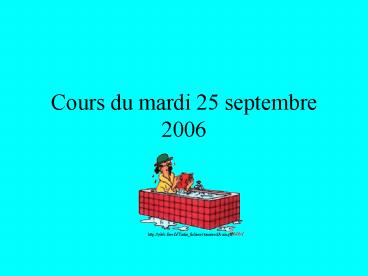Cours du mardi 25 septembre 2006 - PowerPoint PPT Presentation
1 / 12
Title:
Cours du mardi 25 septembre 2006
Description:
Changes in understanding of what children know and how they ... content de lui-m me, se mit courir nu dans les rues en criant: ' eur ka '. (' J'ai trouv ' ... – PowerPoint PPT presentation
Number of Views:76
Avg rating:3.0/5.0
Title: Cours du mardi 25 septembre 2006
1
Cours du mardi 25 septembre 2006
http//ydeb.free.fr/Tintin_fichiers/tournesol/bain
.gif
2
What Children Know and How They Learn
- Changes in understanding of what children know
and how they learn have been profound in the past
several decades. This new understanding is
central to formulating how science should be
taught. In summary - Children entering school already have substantial
knowledge of the natural world, much of which is
implicit. - What children are capable of at a particular age
is the result of a complex interplay among
maturation, experience, and instruction. What is
developmentally appropriate is not a simple
function of age or grade, but rather is largely
contingent on their prior opportunities to learn.
- Students knowledge and experience play a
critical role in their science learning,
influencing all four strands of science
understanding. - Race and ethnicity, language, culture, gender,
and socioeconomic status are among the factors
that influence the knowledge and experience
children bring to the classroom. - Students learn science by actively engaging in
the practices of science. - A range of instructional approaches is necessary
as part of a full development of science
proficiency.
http//science.nsta.org/nstaexpress/nstaexpress_20
06_09_25_execsummary.htm
3
Childrens experience varies with their cultural,
linguistic, and economic background. Such
differences mean that students arrive in the
classroom with varying levels of exposure to
science and varying degrees of comfort with the
norms of scientific practice. These differences
require teachers sensitivity to cultural and
other background differences and their
willingness and skill to adjust instruction in
light of these differences. Adjusting for
variation in students background and experience
does not mean dumbing down the science curriculum
or instruction. All children bring basic
reasoning skills, personal knowledge of the
natural world, and curiosity, which can be built
on to achieve proficiency in science.
http//www.nationalacademies.org/morenews/20060921
b.html
4
Je vais vous raconter une histoire
- Il était une fois dans la ville de Syracuse,
- en Sicile
5
- Un roi qui sappelait Hiéron II
- Il voulait avoir une belle couronne dor pur.
http//www.ac-versailles.fr/pedagogi/musee-educati
on/images/collections/images/couronne20de20lauri
er.jpg
6
- Il en donna donc une certaine quantité à un
orfèvre. - Mais si ce dernier avait gardé une partie de lor
pour lui ? - Cependant pas question de toucher à la couronne.
Comment faire pour savoir sil y a eu fraude ?
7
- Le roi demanda conseils à un savant bien connu
Archimède.
http//www.free-people.org/fotos-photos/archimede.
jpg
8
- Ce dernier trouva la solution dans son bain
http//www.intelligence-creative.com/z0651_archime
de.jpg
9
- et tellement content de lui-même, se mit à courir
nu dans les rues en criant eurêka . ( Jai
trouvé )
10
Essayez de deviner quelle était la réponse à
lénigme trouvée par Archimède.
11
Consignes
- Trouvez un contexte approprié pour une classe
dimmersion (?). - Trouvez la masse volumique des différents cubes.
- Faites tous vos calculs dans Excel.
12
Exercice récapitulatif
- Est-ce une pierre mystérieuse ?
http//ydeb.free.fr/Tintin_fichiers/tournesol/bain
.gif































